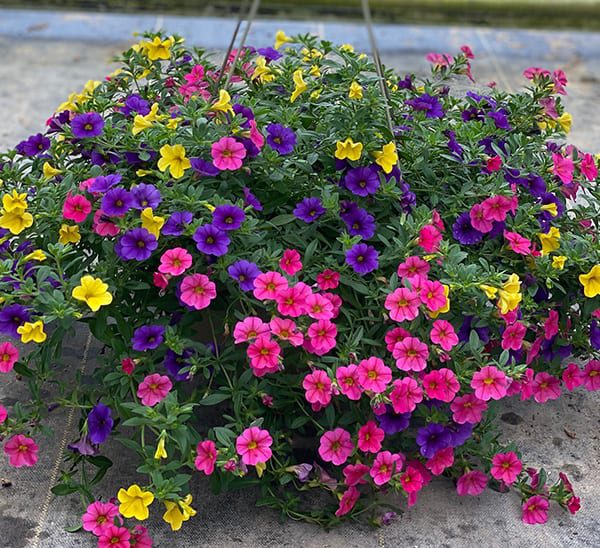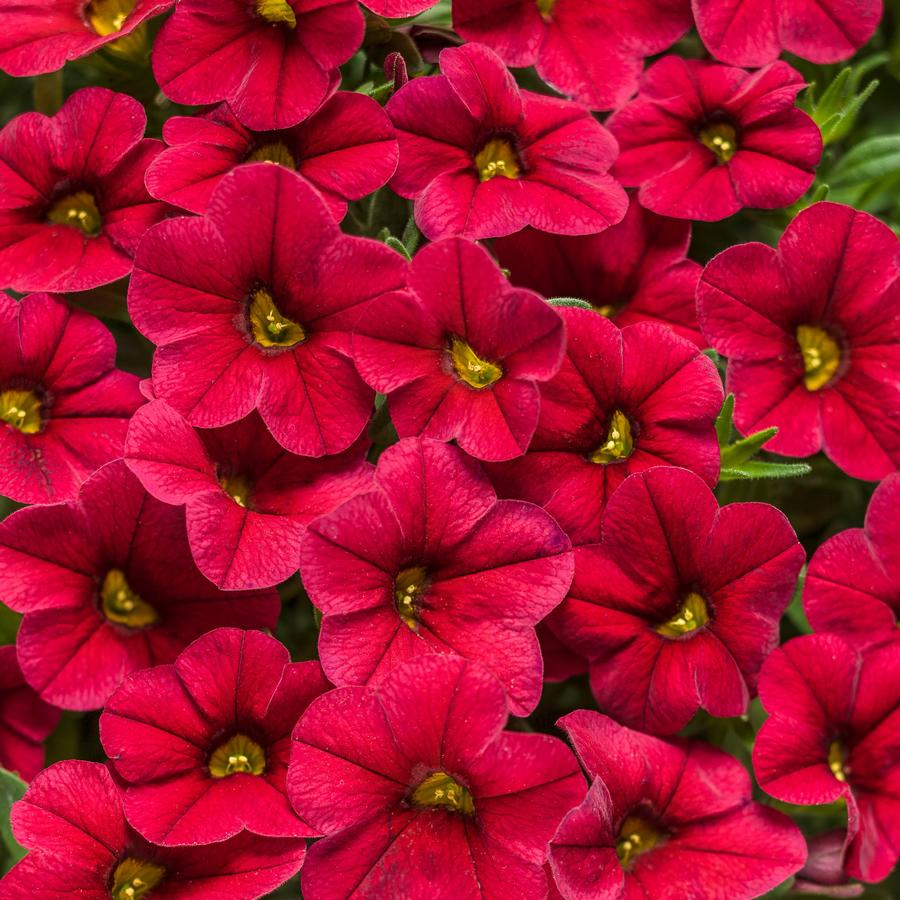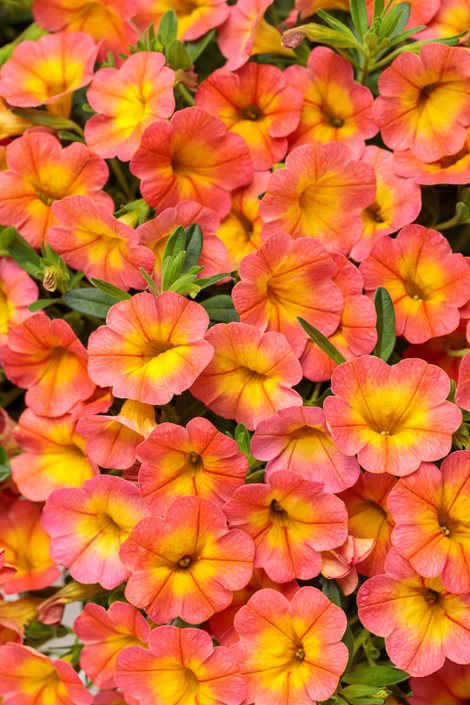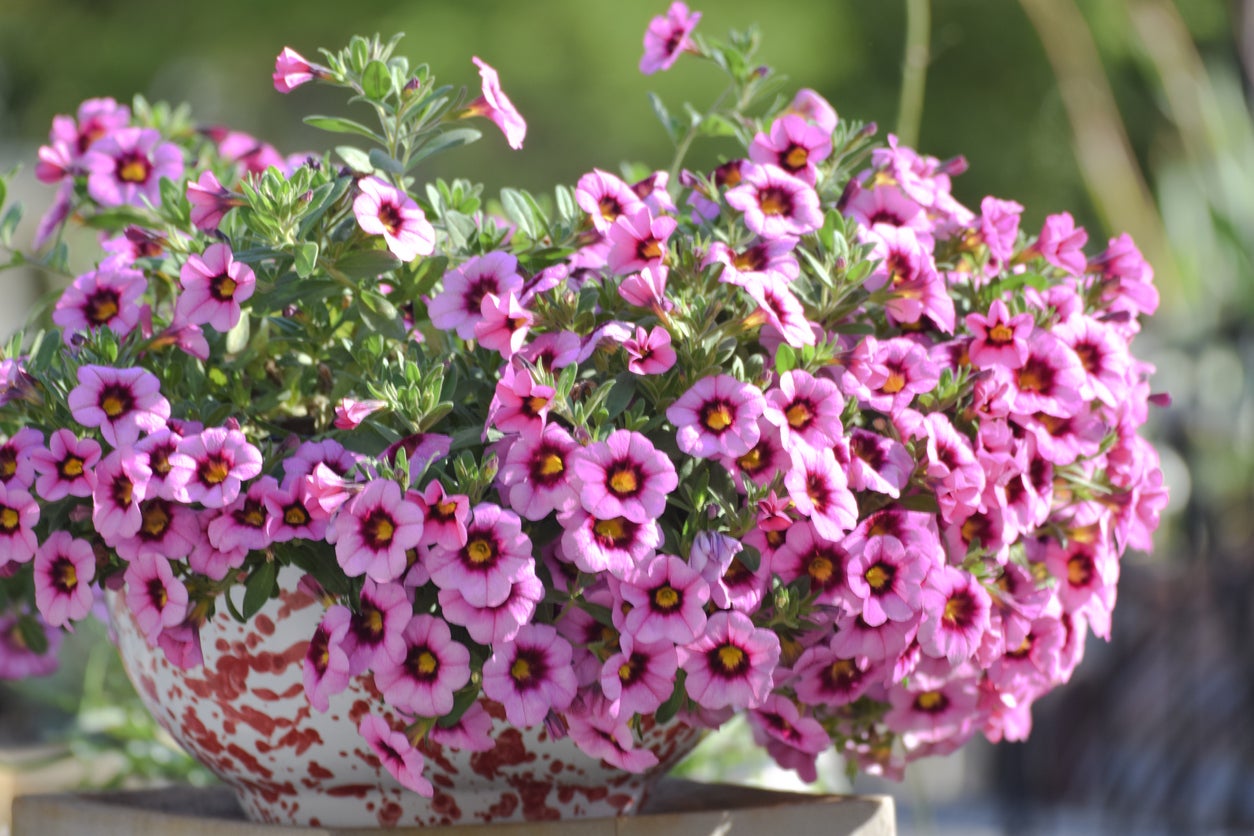What Affects the Blooming Time of Calibrachoa Flowers
Calibrachoa, also known as Million Bells, is a popular annual flower known for its vibrant, bell-shaped blooms. The blooming time of Calibrachoa can vary depending on several factors, including temperature, light exposure, watering, and fertilization. Understanding these factors can help you optimize the growing conditions for your Calibrachoa and encourage longer blooming periods.
Temperature plays a significant role in the blooming time of Calibrachoa. These flowers thrive in temperatures between 65°F to 75°F (18°C to 24°C), which is ideal for promoting healthy growth and blooming. Avoid exposing your Calibrachoa to extreme temperatures, as this can shorten the blooming period or even prevent blooming altogether.
Light exposure is another crucial factor that affects the blooming time of Calibrachoa. These flowers require at least 6 hours of direct sunlight per day to produce plenty of blooms. However, too much direct sunlight can cause the flowers to fade quickly, so it’s essential to provide some shade during the hottest part of the day.
Watering and fertilization also impact the blooming time of Calibrachoa. Consistent moisture and a balanced fertilizer can promote healthy growth and encourage longer blooming periods. However, over-watering and under-fertilizing can lead to weak and leggy growth, reducing the blooming time.
When considering how long do Calibrachoa bloom, it’s essential to remember that these factors can interact with each other and with the specific variety of Calibrachoa you’re growing. By understanding and optimizing these factors, you can encourage longer blooming periods and enjoy the vibrant blooms of your Calibrachoa for an extended time.
How to Encourage Longer Blooming Periods in Calibrachoa
To maximize the blooming time of Calibrachoa, it’s essential to provide optimal growing conditions and employ techniques that promote healthy growth and blooming. One of the most effective ways to encourage longer blooming periods is through deadheading, which involves removing spent blooms to encourage the plant to produce more flowers.
Deadheading is a simple process that can be done regularly to promote continuous blooming. Simply snip off the spent blooms with scissors or pinch them off with your fingers, making sure to remove the entire flower stem. This will encourage the plant to produce new blooms and extend the blooming period.
Pruning is another technique that can help promote longer blooming periods in Calibrachoa. Pruning involves cutting back the plant to maintain its shape and encourage new growth. By pruning your Calibrachoa regularly, you can encourage the plant to produce more blooms and extend the blooming period.
In addition to deadheading and pruning, providing optimal growing conditions is crucial for promoting longer blooming periods in Calibrachoa. This includes providing plenty of sunlight, water, and fertilizer. Calibrachoa prefers well-draining soil and full sun to partial shade, so make sure to provide the right conditions for your plant.
By following these tips and techniques, you can encourage longer blooming periods in your Calibrachoa and enjoy the vibrant blooms for an extended time. Remember to also consider the specific needs of your Calibrachoa variety, as some may require more attention than others. With proper care and attention, you can maximize the blooming time of your Calibrachoa and enjoy the beauty of these stunning flowers.
When considering how long do Calibrachoa bloom, it’s essential to remember that the blooming period can vary depending on the specific variety and growing conditions. By providing optimal growing conditions and employing techniques that promote healthy growth and blooming, you can encourage longer blooming periods and enjoy the beauty of these stunning flowers.
Understanding the Different Types of Calibrachoa and Their Blooming Habits
Calibrachoa is a diverse genus of plants, with numerous varieties that differ in their growth habits, flower colors, and blooming periods. Understanding the unique characteristics of each type of Calibrachoa can help you better appreciate their blooming habits and provide the best care for your plants.
One of the most popular types of Calibrachoa is the ‘Million Bells’ variety, which is known for its prolific blooming habit and vibrant flower colors. This variety typically blooms for 6-8 weeks, producing hundreds of small, bell-shaped flowers that cascade down the sides of containers or hanging baskets.
Another popular variety is the ‘Calibrachoa hybrida’, which is a hybrid of the ‘Million Bells’ and other Calibrachoa species. This variety is known for its larger flowers and longer blooming period, typically lasting 8-10 weeks.
The ‘Calibrachoa parviflora’ variety is a more compact type of Calibrachoa, with smaller flowers and a shorter blooming period of 4-6 weeks. However, this variety is ideal for small containers or edging, as it produces a dense mat of flowers that can spill over the sides of the container.
Other types of Calibrachoa, such as the ‘Calibrachoa x hybrida’ and ‘Calibrachoa grandiflora’, have varying blooming periods and growth habits. Some varieties may bloom for only 2-3 weeks, while others may produce flowers for 12 weeks or more.
When considering how long do Calibrachoa bloom, it’s essential to remember that the blooming period can vary significantly depending on the specific variety and growing conditions. By understanding the unique characteristics of each type of Calibrachoa, you can provide the best care for your plants and enjoy their beautiful blooms for an extended time.
The Average Blooming Time of Calibrachoa: What to Expect
The average blooming time of Calibrachoa can vary depending on the specific variety, growing conditions, and care. However, most Calibrachoa varieties typically bloom for 6-12 weeks, with some varieties blooming for up to 16 weeks or more.
During this time, Calibrachoa produces hundreds of small, bell-shaped flowers that cascade down the sides of containers or hanging baskets. The frequency of blooming can also vary, with some varieties producing new flowers continuously throughout the blooming period, while others may produce flowers in waves.
For example, the ‘Million Bells’ variety of Calibrachoa typically blooms for 6-8 weeks, producing hundreds of small, yellow, orange, or red flowers. The ‘Calibrachoa hybrida’ variety, on the other hand, blooms for 8-10 weeks, producing larger, more vibrant flowers.
Other factors, such as temperature, light exposure, watering, and fertilization, can also impact the blooming time of Calibrachoa. For example, Calibrachoa grown in warmer temperatures (above 75°F) may bloom for a shorter period, while those grown in cooler temperatures (below 65°F) may bloom for a longer period.
When considering how long do Calibrachoa bloom, it’s essential to remember that the blooming period can vary significantly depending on the specific variety and growing conditions. By understanding the average blooming time of Calibrachoa and the factors that impact it, you can provide the best care for your plants and enjoy their beautiful blooms for an extended time.
In general, Calibrachoa can be expected to bloom for the following periods:
- 6-8 weeks: ‘Million Bells’ variety
- 8-10 weeks: ‘Calibrachoa hybrida’ variety
- 10-12 weeks: ‘Calibrachoa grandiflora’ variety
- 12-16 weeks: ‘Calibrachoa x hybrida’ variety
Keep in mind that these are general guidelines, and the actual blooming time of your Calibrachoa may vary depending on the specific variety and growing conditions.
How to Care for Calibrachoa During the Blooming Period
Proper care during the blooming period is crucial to ensure that your Calibrachoa plants continue to produce vibrant and healthy blooms. Here are some tips on how to care for your Calibrachoa during this time:
Watering: Calibrachoa requires consistent moisture, especially during the blooming period. However, over-watering can lead to root rot and other problems. Make sure to water your plants when the top inch of soil feels dry to the touch.
Fertilizing: Feed your Calibrachoa with a balanced fertilizer (10-10-10) once a month during the blooming period. This will provide the necessary nutrients for healthy growth and blooming.
Pest Management: Keep an eye out for pests such as aphids, whiteflies, and spider mites, which can damage your Calibrachoa plants and reduce blooming. Use organic or chemical pest control methods as needed to prevent infestations.
Pruning: Continue to prune your Calibrachoa plants regularly to encourage bushy growth and prevent legginess. Remove any dead or damaged flowers or foliage to maintain the plant’s appearance and promote healthy growth.
Support: Provide support for your Calibrachoa plants, especially if they are top-heavy with blooms. Use stakes or trellises to keep the plants upright and prevent them from toppling over.
Monitoring: Keep an eye on your Calibrachoa plants’ temperature and humidity levels. Most Calibrachoa varieties prefer daytime temperatures between 65-75°F (18-24°C) and nighttime temperatures around 55-65°F (13-18°C). Maintain a humidity level of 40-50% to prevent stress and promote healthy growth.
By following these care tips, you can ensure that your Calibrachoa plants continue to thrive and produce vibrant blooms throughout the blooming period. Remember to adjust your care routine according to the specific needs of your Calibrachoa variety and the climate in your area.
When considering how long do Calibrachoa bloom, it’s essential to remember that proper care during the blooming period can significantly impact the duration and health of blooms. By providing the right conditions and care, you can enjoy your Calibrachoa’s beautiful blooms for an extended time.
Common Mistakes to Avoid When Growing Calibrachoa for Longer Blooms
While Calibrachoa is a relatively low-maintenance plant, there are some common mistakes that can shorten the blooming period or reduce the overall health of the plant. Here are some mistakes to avoid when growing Calibrachoa for longer blooms:
Over-watering: Calibrachoa prefers well-draining soil and can be susceptible to root rot if the soil is too moist. Avoid over-watering, especially during the blooming period, as this can lead to a shorter blooming time.
Under-fertilizing: Calibrachoa requires regular fertilization to promote healthy growth and blooming. Avoid under-fertilizing, as this can lead to weak and leggy growth, reducing the blooming period.
Inadequate pruning: Pruning is essential for promoting bushy growth and encouraging more blooms. Avoid inadequate pruning, as this can lead to leggy growth and a shorter blooming period.
Insufficient light: Calibrachoa requires at least 6 hours of direct sunlight per day to produce plenty of blooms. Avoid placing Calibrachoa in areas with insufficient light, as this can lead to weak and spindly growth.
High temperatures: Calibrachoa prefers daytime temperatures between 65-75°F (18-24°C) and nighttime temperatures around 55-65°F (13-18°C). Avoid placing Calibrachoa in areas with high temperatures, as this can lead to a shorter blooming period.
Pests and diseases: Regularly inspect your Calibrachoa plants for pests and diseases, and take action promptly if you notice any issues. Avoid using chemical pesticides or fungicides, as these can harm the plant and reduce the blooming period.
By avoiding these common mistakes, you can help extend the blooming period of your Calibrachoa and enjoy more vibrant and healthy blooms. Remember to provide optimal growing conditions, regular fertilization, and proper pruning to promote healthy growth and blooming.
When considering how long do Calibrachoa bloom, it’s essential to remember that avoiding common mistakes can significantly impact the duration and health of blooms. By following these tips and avoiding common mistakes, you can enjoy your Calibrachoa’s beautiful blooms for an extended time.
Extending the Blooming Period of Calibrachoa: Tips and Tricks
While Calibrachoa is known for its long blooming period, there are several techniques that can help extend the blooming time even further. Here are some expert tips and tricks to help you get the most out of your Calibrachoa plants:
Pinching: Pinching involves removing the tips of the stems to encourage branching and more blooms. This technique can help extend the blooming period of Calibrachoa by promoting more flowers to form.
Disbudding: Disbudding involves removing the buds from the plant to encourage more blooms to form. This technique can help extend the blooming period of Calibrachoa by promoting more flowers to form.
Using plant growth regulators: Plant growth regulators, such as ethylene inhibitors, can help extend the blooming period of Calibrachoa by slowing down the aging process of the flowers.
Providing optimal growing conditions: Providing optimal growing conditions, such as plenty of light, water, and nutrients, can help extend the blooming period of Calibrachoa.
Deadheading: Deadheading involves removing the spent blooms from the plant to encourage more blooms to form. This technique can help extend the blooming period of Calibrachoa by promoting more flowers to form.
Pruning: Pruning involves cutting back the stems of the plant to encourage more blooms to form. This technique can help extend the blooming period of Calibrachoa by promoting more flowers to form.
By using these techniques, you can help extend the blooming period of your Calibrachoa plants and enjoy more vibrant and healthy blooms. Remember to experiment with different techniques to find what works best for your plants.
When considering how long do Calibrachoa bloom, it’s essential to remember that extending the blooming period requires careful planning and attention to detail. By following these tips and techniques, you can help extend the blooming period of your Calibrachoa plants and enjoy more beautiful blooms.
Conclusion: Maximizing the Blooming Time of Your Calibrachoa
In conclusion, Calibrachoa is a beautiful and versatile flower that can add a pop of color to any garden or indoor space. By understanding the factors that affect the blooming time of Calibrachoa, such as temperature, light exposure, watering, and fertilization, you can take steps to maximize the blooming time of your plants.
Additionally, by following the tips and tricks outlined in this article, such as deadheading, pruning, and providing optimal growing conditions, you can encourage longer blooming periods in your Calibrachoa plants.
Remember, every plant is unique, and what works for one Calibrachoa plant may not work for another. Experiment with different techniques to find what works best for your plants, and don’t be afraid to try new things.
By following these tips and techniques, you can enjoy the beautiful blooms of your Calibrachoa plants for an extended period of time. Happy gardening!
Final Checklist of Tips for Maximizing the Blooming Time of Calibrachoa:
- Provide optimal growing conditions, including temperature, light exposure, watering, and fertilization.
- Deadhead regularly to encourage more blooms.
- Prune regularly to promote bushy growth and encourage more blooms.
- Use plant growth regulators to extend the blooming period.
- Pinch and disbudding to encourage more blooms.
- Avoid common mistakes, such as over-watering, under-fertilizing, and inadequate pruning.
By following these tips and techniques, you can maximize the blooming time of your Calibrachoa plants and enjoy their beautiful blooms for an extended period of time.


:strip_icc():format(webp)/calibrachoa-voodoo-cbef0a14-1bc1070f5a624f9c88196465f19b994f.jpg)




:strip_icc():format(webp)/calibrachoa-Mini-Famous-Double-Yellow-01-hero-8a00c7dc98224488b55c05176ec8503c.jpg)
